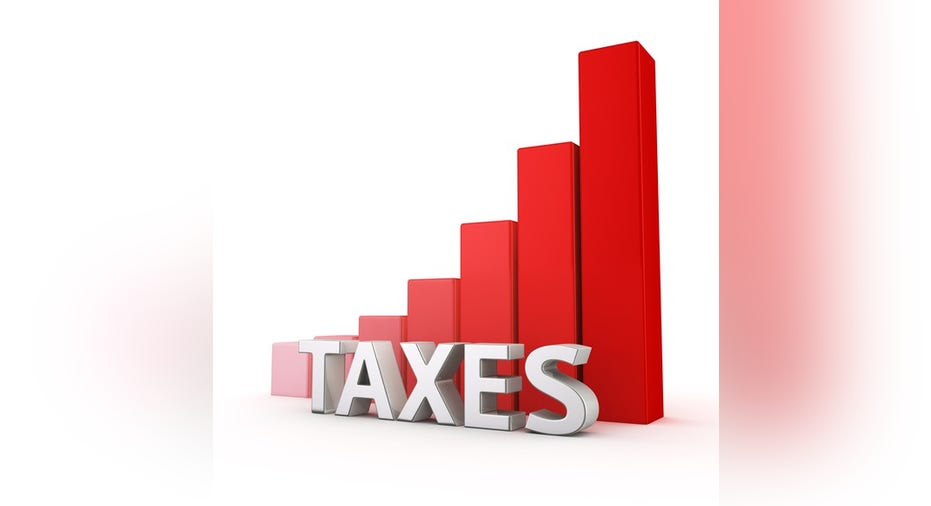The Capital Gains Tax Rate: What You Need to Know for 2017

Whenever you make money on an investment, the IRS is allowed to collect its share. If you're hoping to profit from your investments going forward (and who isn't?), you may be wondering: What is the new capital gains tax rate in 2017?The answer is that the taxes you'll pay on investment gains will depend on your tax bracket and whether you're looking at a short-term gain or a long-term gain. We'll review the income tax rates you may be facing in a series of tables below.
IMAGE SOURCE: GETTY IMAGES.
Short-term capital gains tax rates
Any time you sell an investment you've held for one year or less, you're subject to short-term capital gains taxes. Short-term capital gains are taxed as ordinary income, which means they're taxed the same way your regular paycheck is taxed.
The following table shows what short-term capital gains tax rate you'll fall into as a single tax filer in 2017:
|
Single Filer Tax Bracket/Short-Term Capital Gains Tax Rate |
Income |
|---|---|
|
10% |
$0-$9,325 |
|
15% |
$9,326-$37,950 |
|
25% |
$37,951-$91,900 |
|
28% |
$91,901-$191,650 |
|
33% |
$191,651-$416,700 |
|
35% |
$416,701-$418,400 |
|
39.6% |
$418,401 and above |
TABLE BY AUTHOR. DATA SOURCE: IRS.
If you're married and file a joint return, those numbers look a little different. This table illustrates the short-term capital gains tax rates for joint filers in 2017:
|
Married Filing Jointly Tax Bracket/ Short-Term Capital Gains Tax Rate |
Income |
|---|---|
|
10% |
$0-$18,650 |
|
15% |
$18,651-$75,900 |
|
25% |
$75,901-$153,100 |
|
28% |
$153,101-$233,350 |
|
33% |
$233,351-$416,700 |
|
35% |
$416,701-$470,700 |
|
39.6% |
$470,701 and above |
TABLE BY AUTHOR. DATA SOURCE: IRS.
The more you earn, the higher your tax bracket and corresponding short-term capital gains tax rate will be. Because short-term capital gains are taxed at a higher rate than long-term gains, it often pays to hold your investments long enough to take advantage of those lower rates.
Long-term capital gains tax rates
Long-term capital gains apply to any investment held for a year and a day (or longer), and your tax rate for long-term gains is based on your income level and tax bracket. Currently, the majority of tax filers are subject to a 15% long-term capital gains tax rate. The country's highest earners are subject to a 20% rate, while lower earners don't pay any taxes on long-term capital gains.
The following table shows what your long-term capital gains tax rate will be, based on your current tax bracket:
|
Tax Bracket |
Long-Term Capital Gains Tax Rate |
|---|---|
|
10% |
0% |
|
15% |
0% |
|
25% |
15% |
|
28% |
15% |
|
33% |
15% |
|
35% |
15% |
|
39.6% |
20% |
TABLE BY AUTHOR. DATA SOURCE: IRS.
That said, don't get too comfortable with these numbers. While they're currently valid, once President-elect Donald Trump takes office, they could very well change. Trump's plan is to reduce the present number of tax brackets to just three. The following table shows what the new tax brackets will look like if his proposal goes through:
|
Tax Bracket |
Income: Single Tax Filer |
Income: Joint Tax Filer |
Long-Term Capital Gains Tax Rate |
|---|---|---|---|
|
12% |
$0-$37,500 |
$0-$75,000 |
0% |
|
25% |
$37,500-$112,500 |
$75,000-$225,000 |
15% |
|
33% |
$112,500 and above |
$225,000 and above |
20% |
TABLE BY AUTHOR. DATA SOURCE: DONALDJTRUMP.COM.
While some tax filers won't be impacted by Trump's plan, others stand to lose out -- namely, higher earners who might see their long-term capital gains tax rate go up from 15% to 20%. Case in point: Currently, a couple filing jointly earning $230,000 would fall into the 28% tax bracket, and therefore be subject to a long-term capital gains tax rate of 15%. Under Trump's plan, that same couple would now not only fall into a higher tax bracket, but get hit with a long-term capital gains tax rate of 20%.
Of course, there's no guarantee that Trump's proposal will actually go through. But if it does, depending on your income level, you might see some big changes to your capital gains tax rates. Either way, it's important to know what's on the table so that you can plan accordingly.
{%sfr%}
Try any of our Foolish newsletter services free for 30 days. We Fools may not all hold the same opinions, but we all believe that considering a diverse range of insights makes us better investors. The Motley Fool has a disclosure policy.